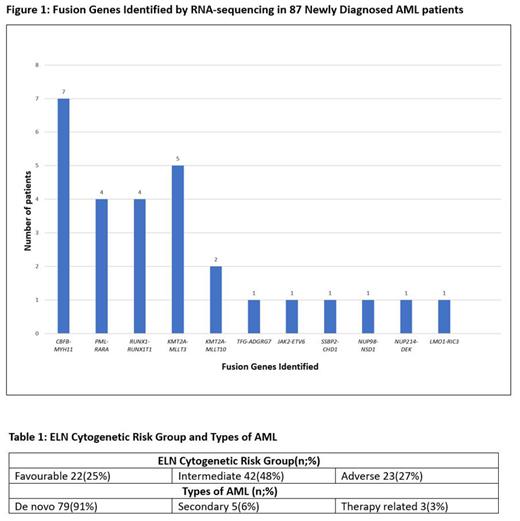Background: Acute Myeloid Leukaemia (AML) is a clinically heterogenous disease characterised by chromosomal and genetic abnormalities which guide risk stratification and management. Hence timely cytogenetic and molecular profiling is essential to initiate appropriate treatment. Approximately 30% of AML cases have fusion genes. We use a combination of fluorescence in situ hybridization (FISH) and the Acute Leukaemia Diagnostic Panel Real-Time PCR assay and targeted RNA-sequencing (Archer Fusion Plex Pan-Heme panel) to rapidly screen for common chromosomal abnormalities and fusion genes.
The Fusion Plex Pan-Heme panel is an Anchored Multiplex PCR (AMP™)-based next-generation sequencing (NGS) product to detect and identify fusions, point mutations and expression levels from ribonucleic acid (RNA) input. Both known and novel fusions can be identified.
The Acute Leukaemia Diagnostic Panel (TruPCR Acute Leukaemia Diagnostic Panel) is a real time PCR assay that detects 14 fusion genes with 28+ breakpoints commonly associated with AML and ALL, and variants in 5 genes associated with AML.
Aims: To evaluate the RNA-sequencing Kit to detect rearrangements, gene fusions on bone marrow specimens from newly diagnosed AML patients; and compare concordance of targeted RNA-sequencing, FISH and qPCR in identifying leukaemia fusion genes.
Methods: We retrospectively reviewed FISH, qPCR and targeted RNA-sequencing data for new AML cases diagnosed in the specialist integrated haematological malignancy diagnostic service (SIHMDS) at University College London Hospital over a one year period: 01 January 2022 to 31 December 2022.
Results: 87 cases were included. They are classified based on ELN Cytogenetic Risk Group and types of AML as per Table 1.
28 (31%) of 87 patients had a detectable fusion gene by targeted RNA-sequencing (Figure 1). 22/28 were detected by targeted RNA-sequencing, FISH and qPCR. The 6/28 fusion genes detected by targeted RNA-sequencing, but not by FISH /qPCR were:
- TFG-ADGRG7 (n=1)
- NUP98-NSD1 (n=1)
- JAK2-ETV6 (n=1)
- LMO1-RIC3(n=1)
- SSBP2-CHD1 (n=1)-clinical significance not known
- CBFB-MYH11 (n=1) rare breakpoint - detected by FISH, not by PCR
The discordant results were due to unavailability of probes/genes in FISH and qPCR panels.
Summary/Conclusion: The ability to risk-stratify newly diagnosed AML patients allows earlier initiation of targeted therapies. We found that targeted RNA-sequencing (Archer Fusion Plex) is sensitive and showed 100% concordance in identifying fusions associated with good cytogenetic risk AML. Targeted RNA-sequencing can also identify high risk fusion genes such as NUP98-NSD1 for which FISH fusion probes are not routinely used. These may have been otherwise undetected, but can subsequently be confirmed by RT-PCR and importantly allow the generation of molecular measurable residual disease (MRD) assays to assess treatment response.
We conclude that targeted RNA-sequencing can be implemented in a diagnostic laboratory to complement FISH-analysis for the detection of recurrent and rare gene fusions in AML diagnosis.
Disclosures
O'Nions:Astellas: Honoraria; Jazz: Honoraria; Ellipses Pharma: Research Funding; Abbvie: Consultancy. Wilson:Imago BioSciences, Inc., a subsidiary of Merck & Co., Inc., Rahway, NJ, USA: Research Funding.


